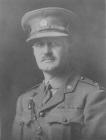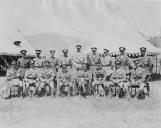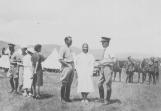8
It was during the interwar period that the veteran's of the 2nd CMRs formed an association called the "Whizzbang's" in honour of the regiment's wartime commander, Lt. Col. G. C. "Whizzbang" Johnston DSO, MC. It was his diary which became the basis for the unit's history, the "2nd Canadian Mounted Rifles (British Columbia Horse) in France and Flanders" published by the association in 1932.Four years of total war had left more than 60,000 Canadian dead in military cemetaries in France and Flanders. True, the Canadian Corps, a volunteer army, had honoured itself beyond expectation throughtout the conflict, but the sacrifice in lives, the unromantic squalor of trench warfare had engendered in many people a permanent aversion to war. Popular sentiment during the 1920s and 1930s was therefore, decidedly pacifist. Government cuts in expenditures reflected that prevailing attitude.
10
The success of the unit again depended in large measure on local initiative and self-help. Officers regularily bought their own uniforms and kit. Frequently, all ranks would donate their pay for the service in the regiment to a fund set up to purchase uniforms or pay rent on the drill hall. Once again, the unit relied on parades, athletic events and social affairs to raise funds and encourage recruiting. These methods worked tolerably well during the properous years of the 1920s but after the Depression began in 1929 the funds declined markedly.13
Lack of money affected the BCMRs in a variety of ways. For much of the interwar years Regimental Headquarters (RHQ) and 'A' squadron remained in Vernon, with 'B' squadron in Kelowna and 'C' squadron in Penticton. Of these, only Vernon had a proper armoury. In Penticton, 'C' squadron rented the Badminton Club (used by several Cadet Corps until recently), and parts of the local arena. For many years, 'B' squadron used a small room above a bakery shop and later the upper floor of a garage and funeral parlour, for offices and training.Equipment remained the WW I surplus kit until 1939. However, there was no return to the scarlet tunics and buff breeches worn by the old 30th BCH. Instead, the khaki field service uniform worn by Canadian cavalry units of WW I were retained, along with the rifles and bayonets. Defence regulations provided that not everyone would receive uniforms, equipment, or pay to attend summer camps.
16
Shortage of money also affected the training of officers and non-commissioned officers (NCOs). In order to qualify for promotion officers and NCOs were required to travel to regular force training facilities outside of the Okanagan Valley, often for periods of weeks, for courses and examinations in modern tactics and techniques. Many of the men could not afford to be away from their jobs for that length of time. To alleviate that problem regular force instructors were sometimes dispatched to local communities to teach courses at night. After the onset of the Depression, the numbers of officers permitted to attend courses and the number of instructors sent, was not sufficient to satisfy the need.In 1929, the regiment became the BC Dragoons as it was thought that it would help avoid any future deployment as Infantry. In 1935, the Department of Defence paid $1,000.00 to obtain the old school on Richter St. in Kelowna, for 'B' squadron, as a temporary armoury. With reasonable accomodations in Kelowna, RHQ was moved there in 1936. This became one of many moves back and forth between Vernon and Kelowna.
18
Cavalry training was exciting. Mounted drill with sword or lance remained the staple of training throughout those years. Exercises included bare-back wrestling in which mounted troopers without saddles, would wrestle opponents off their mounts without losing their own. Another favorite was tent pegging in which a galloping trooper would attempt to uproot a tent peg with his lance. Miscalculations could render the man unhorsed in very short order. Finally, there was the 'Balaclava Melee' in which mounted teams of four heavily padded troopers charged each other, swinging wooden swords with the winners being those who succeessfully knocked paper ribbons from the tops of their opponent's helmets without losing their own.Of course, many recruits didn't know how to ride. Older veterans recall a full-sized wooden replica horse inside the Kelowna Armoury for training newcomers how to saddle, bridle, and sit when it came to the real thing. Outside, a typical drill involved tying the halter of a horse to the tail of the one in front with approximately twenty mounts secured this way in a circle. The recruits would ride bare-back at the trot, and the gallop, round and round, falling off and getting back on, until they could be assured of staying on.








